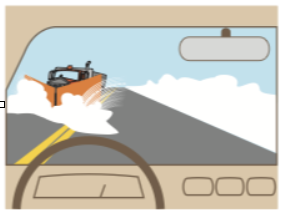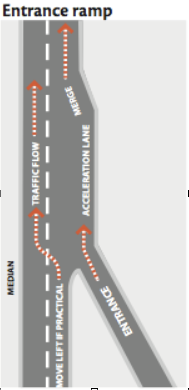Session 23 – Winter Driving and Adjusting to Traffic
WINTER DRIVING
Each year about 30 snowstorms drop about 50 inches of snow in Wisconsin. Winter driving calls for special techniques:
Winter Driving Safety Tips
- First is worst. In the first storm of the season, most drivers have forgotten their safe winter driving skills. They’ll drive too fast and try to stop too quickly. Go slow. Increase following distances. Drive defensively. Relearn your skills.
- Go slow. Drive well below the posted speed limit. Posted limits are intended for summer months on dry pavement. Avoid sudden, sharp turns. Use light braking by gently pumping the brakes.
- Plan ahead. Plan on trips taking extra time. Leave earlier. Consider an alternate route. STAY HOME if conditions are too bad.
- Use your head, use your feet. Never use cruise control on slippery roads.
- Lighten up. Turn on your headlights. To prevent glare, avoid using your high beams during a night storm.
- Wear your seatbelts.
- Give snow plows room. Snowplows are wide. They often need
to operate very close to the center line. Sometimes they throw up clouds of snow, which affects your vision. Slow down and give them as much room as possible. On roads with a posted speed limit of 35 mph or more, the law requires drivers to stay at least 200
feet behind a snow plow when its red or amber lights are on.

ADJUSTING TO TRAFFIC
On a roadway with multiple lanes going in the same direction, crashes involving two or more vehicles often happen
when drivers go faster or slower than other vehicles.
Keep pace with traffic: If you are driving faster than other traffic,
you will need to keep passing others. Each time you pass someone, there is a greater chance for a collision. The vehicle you are passing
may change lanes or, on a two-lane road, an oncoming vehicle may suddenly appear. Slow down and keep pace with other traffic. Speeding does not save more than a few minutes for each hour of driving.
Going much slower than other vehicles can be just as bad as speeding. It is dangerous and you can be ticketed for impeding traffic. It tends to make vehicles bunch up behind you and causes other traffic to pass you. If vehicles are lined up behind you, pull over when safe to do so and let them pass. You should either drive faster or consider using a road with slower posted speeds.
Entering traffic: When you merge with traffic, try to enter at the same speed that traffic is moving. High-speed roadways generally have ramps to give you time to build up your speed. Use the ramp to reach the speed of other vehicles before you merge into traffic. Do not drive to the end of the ramp and stop or you will not have enough room to get up to the speed of traffic. Also, drivers behind you will not expect you to stop. If they are watching the traffic on the main road, you may be hit from the rear. If you have to wait for space to enter a roadway, slow down on the ramp so you have some room to speed up before you have to merge. You must yield to traffic already moving on the roadway.

Leaving traffic: Keep up with the speed of traffic as long as you are on the main road. If the road on which you are traveling has exit ramps, do not slow down until you move onto the exit ramp. When you turn from a high speed, two-lane roadway, try not to slow down too early if you have traffic following you. Tap your brakes quickly but safely and reduce your speed.

Slow moving traffic: Some vehicles cannot travel very fast or have trouble keeping up with the speed of traffic. If you spot these vehicles early, you have time to change lanes or safely slow down. Slowing suddenly can cause a crash.
Watch for large trucks and small cars on steep grades or when they are entering traffic. They can lose speed on long or steep uphill climbs and it takes longer for them to get up to speed when they enter traffic.
Farm tractors, animal-drawn vehicles and roadway maintenance vehicles usually go 25 mph or less. These vehicles should have a slow-moving vehicle (SMV) sign on the back.
Bicyclists should have reflectors or lights on their bikes. However, some bikes may not have this equipment. Be especially watchful for bikes.
Trouble spots: Wherever people gather or traffic is heavy, your room to move is limited. You need to lower your speed to have time to react in a crowded space. Here are some
of the places where you may need to slow down:
- shopping centers, parking lots and downtown areas. These are busy areas with vehicles, pedestrians and bicyclists stopping, starting and moving in different directions.
- rush hours. Rush hours often have heavy traffic and drivers may be in a hurry.
- narrow bridges and tunnels. Vehicles approaching each other are forced closer together.
- toll plazas. Vehicles are changing lanes and preparing to stop, and then speeding up again when leaving the plaza. The number of lanes could change both before and after the plaza.
- schools, playgrounds and residential streets. These areas often have children present. Always watch for children crossing the street, or running or riding into the street without looking.
- railroad crossings. You need to make sure there are no trains coming and that you have room to cross. Some crossings
are bumpy so you should slow down to cross safely.
